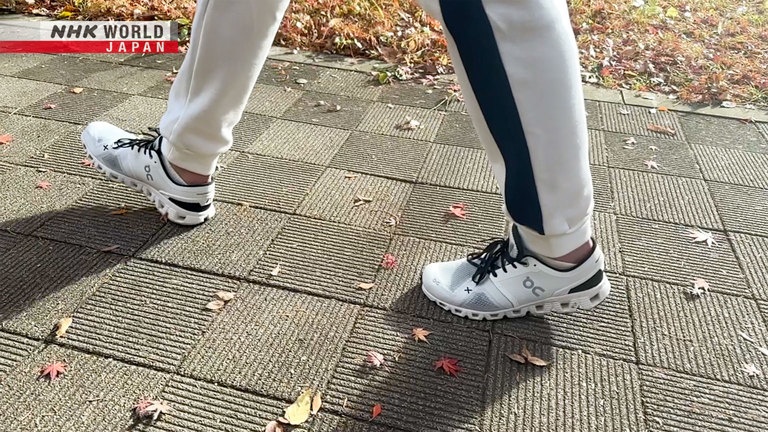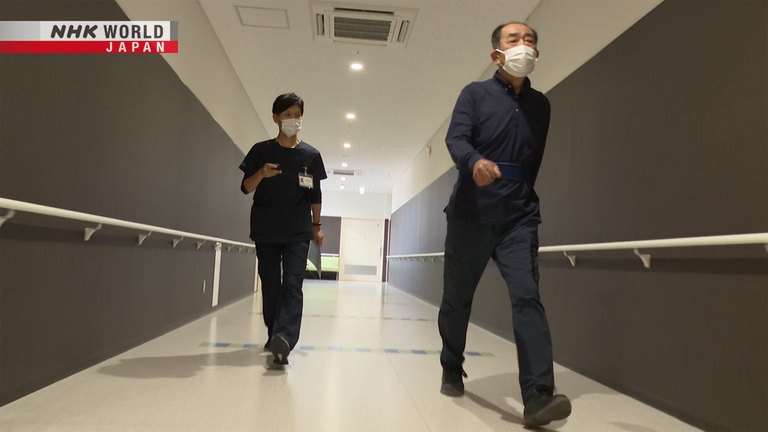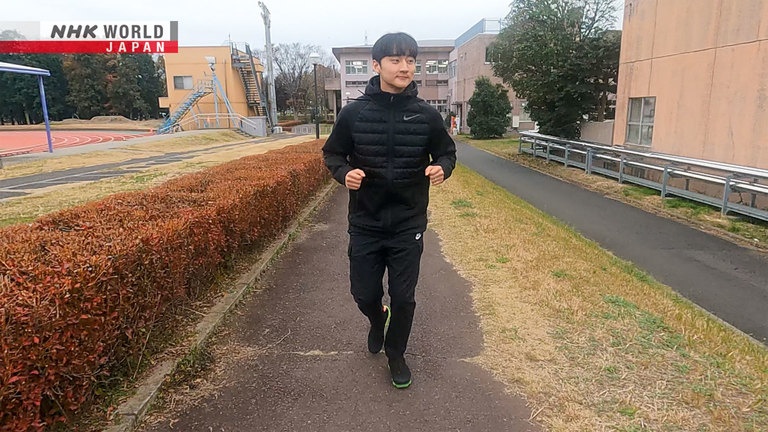New Findings on Walking and Running
Interval Walking Training, developed in Japan, is attracting global attention. The latest scientific findings show that alternating between fast walking and slow walking promotes health.




Transcript
Join us as we explore Medical Frontiers.
According to the World Health Organization,
physical inactivity is the 4th leading risk factor for death in the world.
Walking has gained attention as one of the most effective ways of combatting a sedentary lifestyle.
Japanese researchers have published reports
suggesting that a unique walking method developed in the country
improves conditions such as diabetes and hypertension.
This method is revolutionizing cardiac rehabilitation.
There are also new findings regarding running.
Researchers have discovered that "slow running" may activate the brain.
Today, we focus on these discoveries and introduce easy exercises that you can start right away to improve your health.
So, let's begin!
Located about three hours northwest of Tokyo by train is the city of Matsumoto.
While global studies traditionally emphasized the number of steps,
researchers in Matsumoto are pioneering a unique approach that goes beyond mere step count.
This method, known as Interval Walking Training, or IWT,
involves alternating between slow walking and fast walking.
A study was conducted with middle-aged and older participants, divided into three groups:
one that did no walking, another that walked 10,000 steps a day
and a third that did 30 minutes of daily IWT.
Five months later, the IWT group showed a decline in systolic blood pressure
over four times greater than the 10,000-step group.
Additionally, their diastolic blood pressure had decreased 2.5 times.
If this new result can be maintained for five years, the risk of stroke is believed to drop by 40 percent.
Another study found that IWT lowered the depression index
by 50 percent in middle-aged and older people with depression symptoms.
It also extended their sleep efficiency by 12 percent.
Interval Walking Training was developed by a team at Shinshu University in Matsumoto.
The university is playing a leading role in teaching IWT to middle-aged and older people.
I'm 82.
I thought exercise would be good for my health.
I used to get sick often, but now,
I rarely catch colds. It's a major change.
Before beginning IWT, participants wear a device that can measure the amount of exercise they do.
3,2,1... Go!
Participants begin by walking at their own pace.
They walk at a relaxed speed, as if taking a stroll.
Three minutes later...
Now, swing your arms vigorously.
1,2,1,2! Make it bigger!
Following the instructions, they speed up.
They take large steps, swinging their arms widely and opening their chest.
They increase their pace until they're slightly out of breath.
After three more minutes...
Slow down when the music begins.
The participants return to a slower walking pace.
They take the opportunity to catch their breath or stretch.
Three minutes of slow walking followed by three minutes of fast walking make up one set.
Five sets are required, totaling 30 minutes.
IWT was initially designed for athletes
to boost their fitness by alternating between intense exercise and short breaks.
It has been transformed into a walking method that anyone can do.
It's refreshing. I'm sweating a lot.
I'm not that tired. I've gotten used to it.
A team led by Shinshu University Professor Masuki Shizue has been studying IWT.
Dr. Masuki, it is great to have you on the program.
It's my pleasure.
Such groundbreaking and fascinating research.
Our strength is that we have data on the effects
of different amounts and intensities of walking.
We have accumulated such data from nearly
10,000 people who took part in our studies.
Masuki's team did an experiment with a group that did no walking,
another that walked 10,000 steps a day, and a third that did IWT.
After five months, the results showed that the hamstring muscles, necessary for raising the legs,
were 12 percent stronger in the IWT group than in the 10,000-step group.
Peak oxygen uptake, a measure of aerobic endurance, was also 10 percent higher in the IWT group.
The exercise had improved their physical strength.
Masuki believes that the group that walked 10,000 steps daily
may not have walked with sufficient intensity and speed to improve their fitness.
IWT can improve physical strength
and provide other benefits.
The key is to do it at a certain intensity
for a certain duration.
Michael Joyner, an expert in sports medicine, was among the first in the world to recognize the significance of IWT.
I think it's a real breakthrough.
And what's great about it is you have the community involvement, you've got the university involvement,
and you've got principles of the same sorts of training that the elite athletes use to apply to older people.
So it's really a just a great kind of three fold way to send a message and do good things for older people.
In 2020, the American Physiological Society featured IWT in a textbook used by physicians and researchers worldwide.
These are becoming textbook studies, widely cited and again, both the specifics of their program,
but also as people try to learn lessons from their success
and see how those lessons can also be applied to their own programs.
Interval Walking Training was developed by Nose Hiroshi, under whom Masuki studied.
Professor Nose, so lovely to meet you.
Nice to meet you.
How do we actually do it?
We start by warming up.
Nose recommends stretching before IWT.
The proper posture is crucial for walking without fatigue.
Look straight ahead, lift your hands as high as possible, then lower them.
Begin with a slow walk.
Walk leisurely, enjoying the surroundings.
First is nice and slow. So we can have a conversation.
Big stride? Or not such a big stride?
Keep it small.
I have to ask how old are you? You look so incredibly young.
- Mentally young.
- That's the most important thing.
It's so important to be mentally young.
You should feel relaxed and be able to enjoy conversation during slow walking.
Then what sort of pace are we walking at for the high-intensity walking?
Take big strides.
After 1 to 2 minutes, you'll start to breathe
slightly harder, and your heart rate will increase.
Take longer strides than usual.
So the key thing is this really nice long stride.
Long stride, long stride.
- Make sure that your heels touch the ground first.
- OK, great, so heel-toe.
By bending your arms at a right angle and swinging them back and forth widely,
you will be able to walk with large strides naturally and comfortably.
For slow walking, go as slow as you like.
For fast walking, aim for a speed that slightly tightens your calf muscles.
How many minutes do we need to be aiming for?
- It's important to do 60 minutes of fast walking a week.
- OK, great.
So the 60 minutes is really the key thing a week.
There's no need to do this all at once.
Spreading it out into a few minutes' walk several times a day will give you similar effects.
The team at Shinshu University is conducting joint research with a local hospital
to explore the possibility of introducing IWT into the rehabilitation of heart disease patients.
Onozawa Koichi suffered a myocardial infarction in 2015.
For a while, he couldn't walk properly and had difficulty standing up.
There are significant challenges in the rehabilitation of heart disease patients.
Heart disease patients tend to avoid exercise,
but it's crucial, particularly after diagnosis.
Even after recovering from heart disease,
low physical fitness can lead to a poor prognosis.
Before starting rehabilitation,
heart disease patients are given an accurate assessment of their physical fitness and cardiovascular function.
Based on the results, doctors determine a walking speed that can be comfortably managed.
The patients wear a device that records heart rates and other data during IWT.
Onozawa has been doing IWT for three months.
Please start.
Tailored to each individual's fitness level,
IWT can be done comfortably and safely, even by those with heart conditions.
Switch to fast walking.
Onozawa can now walk quickly without experiencing shortness of breath or palpitations.
Initially, walking 10 minutes was a challenge, but he can now walk continuously for 40 minutes.
In daily life, he can easily walk up slopes.
After the session, the exercise data is shared with the hospital,
allowing doctors to remotely check the patient's heart condition.
In some hospitals, rehabilitation sessions are provided only once a week, instead of the optimal three times,
due to labor shortages or patients living in distant areas.
However, by introducing IWT, which can be done at home and remotely monitored,
it will become possible to offer rehabilitation three times a week.
IWT is easy to do.
It can be done anytime, anywhere.
It lowers the barriers for patients to start exercising
and once they've begun, it's easy to continue.
The research team conducted a study involving 10 heart disease patients, divided into two groups:
one exercised using machines once a week
and the other group, in addition to machine training, did IWT at least twice a week.
After six months, the results showed an improvement in the pumping ability of the heart in the IWT group.
The researchers also measured levels of a hormone called BNP, or brain natriuretic peptide,
which is secreted when the heart is under stress.
The IWT group showed improvement.
However, the patients who did only machine training didn't see improvement, due to insufficient exercise.
Onozawa's current goal is to resume running - something he used to love doing.
I've gained muscle after starting IWT.
I can now stand up and move around easily.
I want to stay healthy for a long time.
If that requires walking, I can easily do it.
Research on Interval Walking Training is progressing around the world.
Kristian Karstoft at the University of Copenhagen is exploring its introduction into diabetes treatment.
We thought that the fairly low intensity was good for our population
because at least in Denmark, most of the individuals who have type two diabetes are not that fit.
They have not been used to doing that much exercise.
Karstoft conducted a study involving middle-aged and older people with diabetes.
They were divided into 3 groups: one did no walking, one walked at a normal pace, and one did IWT.
For four months, he examined fluctuations in their blood sugar levels.
He found that only the IWT group showed a 10-percent decline in blood sugar level variability.
Smaller fluctuations indicate a better control of blood sugar levels, suggesting an improvement in diabetes.
We would have to look into adherence, how we can optimize long term adherence to interval walking training
and how we can maintain the intervention in large populations.
The Shinshu University team is working to create a system in which IWT can be utilized
not only in hospitals, but also in the broader community, with pharmacies playing a central role.
Welcome.
A type two diabetes patient visits the pharmacy.
You're working very hard. Great job!
I can walk for longer periods than before.
You're probably less likely to get tired.
I don't feel tired even after 20 minutes.
First, patients deemed by doctors to need exercise therapy visit a pharmacy with a prescription.
In addition to medications, the pharmacy provides guidance on IWT.
Patients then carry out IWT at home and submit a device with their walking records to the pharmacy once a month.
Pharmacists share this data with the patient's doctor.
The doctor can use the data as a reference for the next examination.
The university uses the accumulated data to explore even more effective instructional methods.
This patient had high fasting blood sugar levels, but they declined 8 percent after 5 months of IWT.
I don't exercise regularly, so I was surprised
I was able to continue. It's easy to do.
It's also great that the pharmacist
helped me to care for my health.
Many patients are told by their doctors to just
walk, and they're unsure about what to do.
We can do more than just
provide patients with medication.
We hope to play a central role in
managing their health.
IWT has also had a significant impact on patients' medical expenses.
We have found that as physical fitness improves,
all age-related conditions are alleviated.
This leads to a reduction in healthcare costs.
We have demonstrated that engaging in IWT
for 5 months reduces medical expenses by 20%,
when compared with a group not doing IWT.
There some research which is now going on based on your incredible research on Interval Walking Training
by you and your teams. How does it make you feel?
Comparing different ethnic backgrounds, including
genetics, can give us a better understanding.
This provides a broader perspective on the effects
of IWT, not limiting our focus to Japan.
Looking ahead, I hope that daily IWT will become
as natural as drinking water or having meals.
I would be very happy to see IWT spreading
not only in Japan, but also around the world.
- So thank you so much.
- Thank you.
A Japanese research team has discovered that a simple exercise could improve brain function.
It involves "slow running," at a pace similar to fast-walking.
In running, there are moments when both feet are off the ground,
while in walking, one foot is always on the ground.
Slow running is a bit more demanding than walking,
but the key is to run at a pace slow enough to keep a smile on your face.
Soya Hideaki has been studying the impact of exercise on the brain for many years.
Continuing moderate to vigorous-intensity
exercises requires high motivation.
If you stop, the benefits end. But there are
questions on the effectiveness of light exercise.
Soya's team examined how slow running affects the hippocampus in the brain, using rats.
The hippocampus is responsible for memory.
A dysfunction of neurons in the hippocampus is thought to result in memory decline and may trigger depression and dementia.
In the experiment, the rats underwent 30 minutes of light- and moderate-intensity running.
While many reports suggest that running boosts memory, it was unclear whether slow running has the same effect.
Soya's team investigated the quantity of genes that improve the function of hippocampal neurons.
The finding reveals that the results of slow running are similar to those in normal running.
In another experiment, the team had the rats run for six weeks, then examined changes in the hippocampus.
These images show neurons in the hippocampus of the rats.
One group did no exercise, another did light-intensity running and a third did vigorous-intensity running.
Showing in red are the newly born neurons.
The number of new neurons increased 1.3-fold in the rats that did vigorous-intensity running,
compared with those without exercise.
But the increase in rats that ran at light-intensity running was about 1.7 times that of the no-exercise group.
Light-intensity running is relaxing and easy,
while vigorous-intensity running requires willpower.
It's tiring and triggers the release of stress
hormones, which negatively affect the hippocampus.
That's why I believe vigorous-intensity running
is not as effective as light-intensity running.
Soya also conducted an experiment to determine whether light-intensity exercise affects the human hippocampus.
Healthy, young participants underwent a pedaling exercise, followed by a memory test.
Neural activity in the hippocampus during this test was observed using a high resolution functional MRI.
Light-intensity exercise improved their test accuracy, compared with when they did no exercise.
Soya also used functional MRI
to examine how neural activity in the hippocampal subregions related to memory changed during the test.
Neural activity significantly improved compared with when the participants did no exercise,
showing that even brief, light exercise can activate the memory system.
Soya also investigated how exercise affects the prefrontal cortex.
Often dubbed the "brain's command center," the prefrontal cortex governs attention and decision-making.
He did a study comparing the decision-making speed of participants
when they did no exercise with when they did light-intensity exercise.
First, the participants took a cognitive test.
Then, for the next 10 minutes, they either did slow running or no exercise.
After that, they took another test.
The results showed that after slow running,
the participants were faster at answering questions than when they did no exercise.
What's more, when examining the changes in neural activity in the left prefrontal cortex,
it was clear that lateral part had become activated.
Neural activity improved when they ran, compared with when they did no exercise.
Exercise activates the brain and muscles
and helps us to feel positive.
It's extremely important for us to feel pleasant.
Exercise is a mood changer.
Emotions are said to form when neural pathways in
the hippocampus or the prefrontal cortex are activated.
Any type of exercise can affect our emotions.
Soya's team is studying whether listening to a groovy rhythm while doing exercise can activate the brain further.
If you think about it, exercise derives from play.
The more you focus on the fun side of exercise,
the more you can benefit from it.
Interval Walking Training and slow running are fairly easy to continue.
The key to longevity through exercise is to continue it in a way that is enjoyable and suited to each person.
And I really hope you'll join in making it a regular habit.